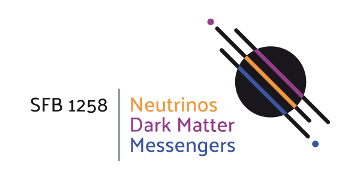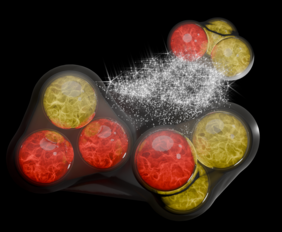One of the biggest challenges in nuclear physics is understanding the strong interaction between particles with different quark content from first principles, starting from the strong interaction between the particles’ constituents, the quarks and the gluons, that convey the interaction force. Calculations based on the theory of strong interaction provide reliable predictions not for normal nucleons with up and down quarks (like protons and neutrons) but for those with heavy quarks, such as hyperons, which contain one or more strange quarks. As hyperons are ultra-short-lived particles, experiments to determine the strong interaction involving these particles were extremely difficult, preventing a meaningful comparison between theory and experiment.
The first measurement of the strong interaction between two particles
A few years ago, Laura Fabbietti and her team at the Technical University of Munich (TUM) applied the femtoscopy technique to solve this measurement problem and determine the strong interaction between systems of two particles: In particle collisions, quark-containing particles are created at extremely small distances that correspond to the range of the strong interaction (1 femtometer = 10-15 m). For pairs of particles that are emitted relatively parallel to each other and continue to move close, there is the possibility of a short interaction before the trajectories of the particles diverge. By measuring their relative velocities during the interaction phase, the resulting strong interaction between the two particles is determined.
The interaction could only be explained by three-body calculations
As a natural progression, the study of three-body systems has emerged. Following this path, Bhawani Singh, a doctoral student in the group of Laura Fabbietti, analyzed the signals of pairs of protons (p) and deuterons (d) produced in proton-proton collisions at the ALICE experiment at the Large Hadron Collider (LHC) at CERN, Geneva. (A deuteron is a deuterium nucleus, also known as heavy hydrogen, containing one proton and one neutron.) The observed p-d signals could not be explained by two-body calculations treating protons and deuterons as point-like and distinguishable particles produced at short distances. In collaboration with scientists from the INFN Pisa, Pisa University (Italy), and North Carolina University, comprehensive three-body calculations were performed and applied for the first time. Only these calculations considering the deuteron’s internal structure, the dynamics of the three nucleons, quantum statistical effects, and the strong interaction could account for the observation.
Potential to study many-body interactions in the future
“The measurements demonstrate the feasibility of studying interactions in a three-particle system by investigating the correlations between deuterons and other particles consisting of quarks, and they also have the potential to explore the effects of genuine many-body interactions at the LHC in the future,” summarises Laura Fabbietti, chair of Experimental Nuclear Physics at TUM.
This would also be a big step towards solving the hyperon puzzle in neutron stars, Fabbietti's ultimate goal. Neutron stars are incredibly dense objects with masses of up to three times the mass of the Sun and radii of about 5 - 10 km. The nature of neutron stars is still unknown. However, due to their high densities, hyperons are expected to be present in the stellar matter. Knowledge of the three- and many-body interaction between hyperons and other nucleons is crucial to determining the state of neutron stars.
Original publication:
ALICE Collaboration: “Exploring the strong interaction of three-body systems at the LHC”
Physical Review X, 24/09/2024
DOI: 10.48550/arxiv2308.16120
Contact:
Technical University of Munich
School of Natural Sciences
Prof. Laura Fabbietti
Chair on Experimental Nuclear Physics
E-Mail: laura.fabbietti@ph.tum.de



